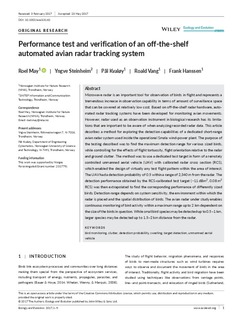Performance test and verification of an off-the-shelf automated avian radar tracking system
Journal article, Peer reviewed

Åpne
Permanent lenke
http://hdl.handle.net/11250/2447944Utgivelsesdato
2017Metadata
Vis full innførselSamlinger
- Scientific publications [1392]
Originalversjon
10.1002/ece3.3162Sammendrag
Microwave radar is an important tool for observation of birds in flight and represents a
tremendous increase in observation capability in terms of amount of surveillance space
that can be covered at relatively low cost. Based on off-the-
shelf
radar hardware, automated
radar tracking systems have been developed for monitoring avian movements.
However, radar used as an observation instrument in biological research has its limitations
that are important to be aware of when analyzing recorded radar data. This article
describes a method for exploring the detection capabilities of a dedicated short-range
avian radar system used inside the operational Smøla wind-power
plant. The purpose of
the testing described was to find the maximum detection range for various sized birds,
while controlling for the effects of flight tortuosity, flight orientation relative to the radar
and ground clutter. The method was to use a dedicated test target in form of a remotely
controlled unmanned aerial vehicle (UAV) with calibrated radar cross section (RCS),
which enabled the design of virtually any test flight pattern within the area of interest.
The UAV had a detection probability of 0.5 within a range of 2,340 m from the radar. The
detection performance obtained by the RCS-calibrated
test target (−11 dBm2, 0.08 m2
RCS) was then extrapolated to find the corresponding performance of differently sized
birds. Detection range depends on system sensitivity, the environment within which the
radar is placed and the spatial distribution of birds. The avian radar under study enables
continuous monitoring of bird activity within a maximum range up to 2 km dependent on
the size of the birds in question. While small bird species may be detected up to 0.5–1 km,
larger species may be detected up to 1.5–2 km distance from the radar.
